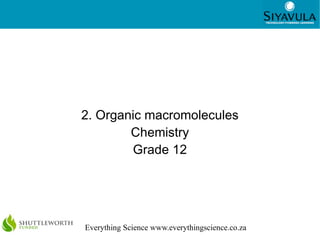
Organic Macromolecules: Polymers, Plastics and Biological Molecules
- 1. 1 2. Organic macromolecules Chemistry Grade 12 Everything Science www.everythingscience.co.za
- 2. 2 Introduction A polymer is a macromolecule that is made up of many repeating structural units called monomers which are joined by covalent bonds. Polymers that contain carbon atoms in the main chain are called organic polymers. Organic polymers can be divided into natural organic polymers (e.g. natural rubber) or synthetic organic polymers (e.g. polystyrene). The polymer polyethene for example, is made up of many ethene monomers that have been joined into a polymer chain. Everything Science www.everythingscience.co.za
- 3. 3 Polymerisation Polymers form through a process called polymerisation. Two examples of polymerisation reactions are addition and condensation reactions. An addition reaction occurs when unsaturated monomers (e.g. alkenes) are added to each other one by one. The breaking of a double bond between carbon atoms in the monomer, means that a bond can form with the next monomer. The polymer polyethene is formed through an addition reaction. In a condensation reaction, a molecule of water is released as a product of the reaction. The water molecule is made up of atoms that have been lost from each of the monomers. Polyesters and nylon are polymers that are produced through a condensation reaction. Everything Science www.everythingscience.co.za
- 4. 4 Properties of polymers The chemical properties of polymers (e.g. tensile strength and melting point) are determined by the types of atoms in the polymer, and by the strength of the bonds between adjacent polymer chains. The stronger the bonds, the greater the strength of the polymer, and the higher its melting point. Some examples are: Hydrogen bonds Polymers that contain amide or carbonyl groups can form hydrogen bonds between adjacent chains. Polymers that contain hydrogen bonds have high tensile strength and a high melting point. Dipole-dipole forces Polyesters have dipole-dipole bonding between their polymer chains. Dipole bonding is not as strong as hydrogen bonding, so a polyester’s melting point and strength are lower than those of the polymers where there are hydrogen bonds between the chains. These polymers have greater flexibility. van der Waals forces These polymers have a low melting point. Everything Science www.everythingscience.co.za
- 5. 5 Plastics One group of synthetic organic polymers, are the plastics. Some types are: Polystyrene is a plastic that is made up of styrene monomers. Polystyrene is used a lot in packaging. Polyvinyl chloride (PVC) consists of vinyl chloride monomers. PVC is used to make pipes and flooring. Polyethene, or polyethylene, is made from ethene monomers. Polyethene is used to make film wrapping, plastic bags, electrical insulation and bottles. Polytetrafluoroethylene is used in non-stick frying pans and electrical insulation. Everything Science www.everythingscience.co.za
- 6. 6 Plastics continued A thermoplastic can be heated and melted to a liquid. It freezes to a brittle, glassy state when cooled very quickly. Examples of thermoplastics are polyethene and PVC. A thermoset plastic cannot be melted or re-shaped once formed. Examples of thermoset plastics are vulcanised rubber and melanine. It is not easy to recycle all plastics, and so they create environmental problems. Some of these environmental problems include issues of waste disposal, air pollution and recycling. Image by Doug Lee Everything Science www.everythingscience.co.za
- 7. 7 Biological macromolecules A biological macromolecule is a polymer that occurs naturally in living organisms. Examples of biological macromolecules include carbohydrates and proteins, both of which are essential for life to survive. Carbohydrates include the sugars and their polymers, and are an important source of energy in living organisms. Glucose is a carbohydrate monomer. Glucose is the molecule that is needed for cellular respiration. The glucose monomer is also a building block for carbohydrate polymers such as starch, glycogen and cellulose. Everything Science www.everythingscience.co.za
- 8. 8 Proteins Proteins have a number of important functions. These include their roles in structures, transport, storage, hormonal proteins and enzymes. A protein consists of monomers called amino acids, which are joined by peptide bonds. A protein has a primary, secondary and tertiary structure. Everything Science www.everythingscience.co.za
- 9. 9 Amino acids and DNA An amino acid is an organic molecule, made up of a carboxyl and an amino group, as well as a carbon side chain of varying lengths. It is the sequence of amino acids that determines the nature of the protein. It is the DNA of an organism that determines the order in which amino acids combine to make a protein. DNA is a nucleic acid. DNA is a polymer, and is made up of monomers called nucleotides. Each nucleotide consists of a sugar, a phosphate and a nitrogenous base. It is the sequence of the nitrogenous bases that provides the ’code’ for the arrangement of the amino acids in a protein. Everything Science www.everythingscience.co.za
- 10. 10 For more practice or to ask an expert for help on this section see: www.everythingscience.co.za ESCAC Everything Science www.everythingscience.co.za
